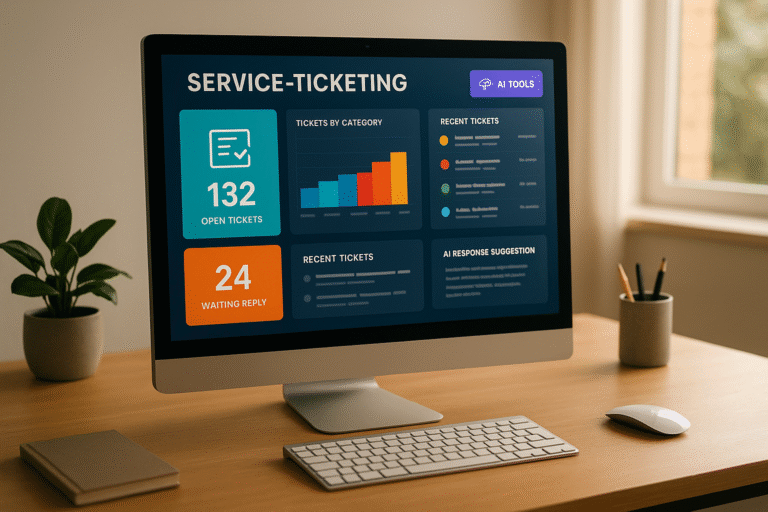Self-service portals: checklist for machine builders
Self-service portals are central platforms that help mechanical engineering companies to improve customer service and optimize internal processes. They enable customers to complete tasks such as spare parts orders, document retrievals or maintenance requests independently around the clock. Here are the most important benefits and functions:
Advantages:
-
Increased efficiency: automation of routine tasks saves time and money.
-
Better customer loyalty: 88% of customers prefer self-service solutions.
-
Sales growth: Companies such as MacDon recorded a 20 % increase in sales.
Must-have functions:
-
User-friendly design: clear navigation, intelligent search functions, responsive layout.
-
Spare parts and document management: access to manuals, spare parts and training videos.
-
IoT integration: real-time machine data for precise maintenance predictions.
-
Security measures: Two-factor authentication, GDPR-compliant data processing.
Quick Comparison of the functions:
|
Category |
Functions |
Priority |
|---|---|---|
|
Basic functions |
Spare parts catalog, product search, mobile use |
High |
|
IoT integration |
Sensor data analysis, maintenance instructions |
Medium |
|
Security |
Encryption, VPN, GDPR compliance |
High |
|
Support |
Live chat, knowledge database, ticket system |
Medium |
Conclusion: Self-service portals offer mechanical engineering companies a practical way to meet customer needs, digitize processes and increase business success. Get started now with a clear strategy and the functions mentioned above!
How mechanical engineering can reduce complexity in service & aftersales and increase sales
Foba ALLTEC takes the complexity out of your product data and delivers it to service and aftersales in a way that even increases sales. Learn more about efficiency and implementation in the company in this presentation from the Empolis Summit 2022.
Must-Have Portal Features
Important functions improve efficiency and customer satisfaction in the manufacturing industry.
Simple design and layout
Self-service portals in mechanical engineering need a user-friendly interface that is specially optimized for B2B. The navigation is based on B2C experiences, supplemented by functions that are relevant for the B2B sector.
Important design elements are:
-
Intelligent search function: quick access to spare parts and documents
-
Clear navigation: Clearly structured according to categories such as maintenance, spare parts and support
-
Responsive design: Optimal display on desktop, tablet and smartphone
After the design, content and user access options come to the fore.
Spare parts and document management
A good example is the Linde Plantserv Portal, which uses intelligent P&IDs to simplify the identification of spare parts [3].
Central functions in document management:
|
Function |
Benefit |
|---|---|
|
Intelligent P&IDs |
Identify spare parts directly by clicking on them |
|
Central archive |
Round-the-clock access to manuals and training videos |
|
ERP integration |
Automatic stock checks and price calculations |
In addition to the management of spare parts and documents, a well thought-out access system is essential.
User access and support system
Efficient access and support management is crucial, as 88% of customers expect self-service access [4]. The system should support different user roles and authorizations.
Important support functions:
-
Ticketing system: recording and tracking of service requests
-
Live chat: direct support for urgent matters
-
Knowledge database: Answers to frequently asked questions and solutions to problems
-
Community area: exchange between users and experts
Integration with CRM systems allows service employees to view the entire customer history and provide personalized support. At the same time, the encryption of sensitive data must meet the highest security standards.
IoT and machine maintenance
The use of IoT systems is fundamentally changing predictive maintenance in mechanical engineering. IoT-supported solutions can reduce downtimes by up to 50% and cut maintenance costs by 20-30%[5]. This technology complements the portal functions described above by providing real-time data and enabling proactive maintenance.
Live machine data display
Important elements:
|
Component |
Function |
Benefit |
|---|---|---|
|
IoT sensors |
Recording temperature, vibration and performance data |
Early detection of problems |
|
Cloud connection |
Central storage and analysis of data |
Access independent of location |
|
Analysis tools |
AI-supported evaluation of sensor data |
More accurate prediction of possible failures |
Maintenance warning system
By using AI, possible failures can be predicted with an accuracy of 90%[5].
Main functions of the system:
-
Automated notifications with prioritization according to urgency
-
Maintenance suggestions based on the analysis results
Online problem solving
Secure data transfer is essential and required:
-
Network segmentation: Separates maintenance systems from the rest of the IT network.
-
Two-factor authentication: Protects against unauthorized access.
-
TLS encryption: Ensures secure data transmission.
The introduction of IoT systems requires a well thought-out security strategy. It is particularly important to implement zero trust principles, including hardware security modules and regularly renewable login credentials.
Customer portals on Salesforce with logicline
A customer portal on Salesforce is the ideal approach for Salesforce users. All data is already integrated and your sales and service team is directly involved. We bring our own templates for the Salesforce Customer Experience Cloud.
Portal setup options
A self-service portal for machine builders must be tailored precisely to the needs of companies and customers. Here are some key options to consider.
Role-based views
Role-based access rights allow you to control the use of the portal in a targeted manner. A well thought-out system ensures that each user group receives exactly the functions they need:
|
Role |
Access areas |
Typical functions |
|---|---|---|
|
Service technician |
Maintenance & repair |
Machine documentation, maintenance logs |
|
Purchaser |
Spare parts |
Ordering system, availability |
|
Plant operator |
Operation |
Operating instructions, training material |
|
Administrator |
System administration |
User administration, configuration |
As an administrator, you should ensure that the authorizations are set up correctly to enable smooth use.
AR support tools
In addition to access control, tools such as AR support offer additional opportunities to increase efficiency. A study shows that 90% of decision-makers invest in AR technologies to improve productivity [6].
Important functions of AR support:
-
Step-by-step instructions with visual overlay
-
Real-time diagnosis of machine statuses
-
Remote support from experts
Language and regional settings
A multilingual portal is essential for international mechanical engineers. This includes support for date formats (e.g. 21.03.2025), number formats (1,234.56) and metric units of measurement.
How to customize your portal:
-
Installation of the required language packages
-
Selection of available languages
-
Creation of content in multiple languages
-
Adaptation of navigation to linguistic and regional requirements
Technical documentation and maintenance instructions should also take regional specifics into account. The default language can serve as a fallback, while users can set their preferred language in their profile.
Setup Steps and Results
Our next steps are based on the functions and technologies explained above.
Implementation guide
The introduction of a self-service portal requires a clear, structured approach.
-
Preparation phase: Develop a detailed project plan with clearly defined milestones. Take into account interfaces to existing systems and allow sufficient time for testing and training.
-
Technical implementation: Ensure that the system architecture complies with current security standards. Integrate existing data sources and ensure compatibility with IoT data. Special attention should be paid to the protection of sensitive data.
-
Employee training: Train all user groups involved and document processes and instructions for various scenarios.
Once these steps have been implemented, it is essential to take strict security precautions for data protection.
Data security measures
Data security plays a crucial role in success. According to studies, industrial control systems are exposed to the same threats as conventional IT systems [7].
|
Security area |
Measures |
Inspection interval |
|---|---|---|
|
Access control |
Two-factor authentication, role-specific access rights |
Quarterly |
|
Data protection |
GDPR-compliant processing, data encryption |
Half-yearly |
|
Remote maintenance |
Secure VPN connections, logging |
Monthly |
The GDPR grants users certain rights, including:
-
Information about stored data
-
Correction of incorrect data
-
Deletion of personal data
-
Restriction of data processing
Performance measurement
According to a study, 81% of customers try to solve problems on their own before contacting support [9]. A key indicator of success is the self-service score, with an average benchmark of 4.1:
|
Metrics |
Target value |
Survey interval |
|---|---|---|
|
Self-service score |
> 4,1 |
Monthly |
To measure success, you should combine key figures with customer feedback. With the help of analysis tools, you can:
-
Identify search terms and frequently visited articles
-
Evaluate unsuccessful searches
-
Monitor the use of help documents
-
measure customer satisfaction via the Net Promoter Score
Portal setup checklist
This checklist will help you to successfully introduce a self-service portal. According to statistics, 88% of customers expect to be able to solve problems themselves using self-service options [10].
Function overview
Here you will find a detailed overview of the necessary functions and technical requirements:
|
Category |
Functions |
Priority |
|---|---|---|
|
Basic functions |
– Spare parts catalog with detailed information |
High |
|
IoT integration |
– Real-time machine data or telemetry data |
Medium |
|
Security |
– Two-factor authentication |
High |
|
Support |
– Round-the-clock availability |
Medium |
After the functional overview, technical requirements help to concretize the implementation:
1. system integration
Ensure that existing ERP systems such as SAP, Microsoft or SAGE are integrated via web services or APIs.
2. user-friendliness
-
Develop a responsive design that works smoothly on mobile devices.
-
Ensure fast loading times and a clearly structured interface.
-
Offer a multilingual user interface.
3. Safety measures
-
Use encrypted data transfers and role-based access rights.
-
Ensure regular security updates.
-
Implement automatic backups to avoid data loss.
These points create a secure and reliable basis for your portal.
Since 79% of customers prefer self-service portals to solve problems on their own [10]you should focus on the most frequently used functions.
“With a self-service portal, you actively involve your customers in processes and meet their frequent need to be able to solve problems themselves.” – Speed4Trade [1]
Proceed step by step and test each phase carefully. Get feedback from pilot users to continuously improve the portal.
Summary and action plan
Main points
Based on the functions and processes presented, key success factors can be derived from which specific measures can be developed. Around 40% of live support requests could be handled via self-service channels – a clear argument in favor of a well-structured customer portal [11].
|
Range |
Success factors |
Measurable goals |
|---|---|---|
|
Customer service |
30 % fewer support requests |
|
|
User acceptance |
User-friendly design |
Over 90 % active use |
First steps
To ensure the success of your portal, the following measures should be prioritized:
-
Creating a technical foundation
A stable technical infrastructure forms the foundation. One example: packaging paper manufacturer Klabin increased its employee utilization rate to over 90% by integrating 70 new services [2]. -
Implement IoT integration
Equip machines with IoT sensors to make telemetry data centrally available. This data helps to accurately predict maintenance and optimize machine performance. -
Develop digital tools
Develop interactive manuals and tutorials. Agricultural machinery manufacturer MacDon increased its overall sales by 20% with an improved dealer portal [2].
Introduce these measures gradually and monitor the results closely to ensure long-term success.
Rethinking service processes: greater efficiency with IoT, AI and self-service
Find out how logicline’s extensions for Salesforce – especially for manufacturers of plant and machinery – can revolutionize your service processes with IoT, AI and self-service solutions. Find out more now and fully exploit service potential!




